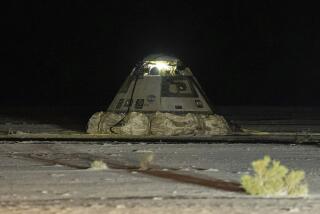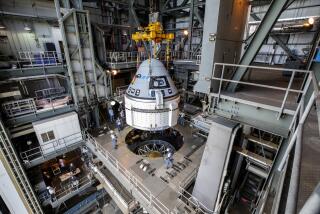Shuttle Suffers Heavy Damage on Safe Return
KENNEDY SPACE CENTER, Fla. — The space shuttle Discovery blew one tire, shredded another, and sustained “fairly significant” damage to its heat protective tiles when it landed here Friday with a U.S. senator and six others aboard.
The spacecraft rolled to a safe stop, but the damage was later found to be the worst in the shuttle program’s 16 flights.
The two 44-inch tires on the right landing gear were damaged. A cursory check indicated that the shuttle’s brakes had locked while it was coasting to a halt on the three-mile-long runway, a space agency spokesman said.
Jesse Moore, head of the shuttle program for the National Aeronautics and Space Administration, said that the damage to the shuttle’s protective tiles, which occurred before touchdown, “looked fairly significant” and could set back preparations for Discovery’s next launch on June 15.
“We could be looking at some delay, no question about it, but I would say it’s too early to speculate,” Moore said.
Gash in Wing Flap
Moore said that something, “possibly ice,” caused a gash about a foot across in a wing flap, probably during Discovery’s re-entry into the atmosphere. He did not rule out the possibility that the shuttle was hit by birds on the final approach to the runway, which cuts through a bird sanctuary.
The shuttle had to make one extra orbit before beginning its descent because of clouds over the Kennedy Space Center.
Sen. Jake Garn (R-Utah), head of the Senate subcommittee that oversees NASA’s budget, had a little trouble getting his “earth legs” back after the landing. The senator, who said that he was sick for two days during the flight, had to be supported by a member of the welcoming committee as he left the shuttle and boarded a van.
But a few hours later, as he prepared to fly to Houston, Garn, 52, appeared to be in good health and said that he felt “great. Great.”
‘A Little Bit Heavy’
“After being in zero-G (weightlessness) for seven days, all this weight is a little bit heavy,” Garn said, dancing a sort of jig for photographers. “But it’s all back. See?”
Garn said that he had “never had a more fantastic experience” than his flight aboard Discovery.
The seven-day flight was marked by triumphs and frustrations for the crew of six men and one woman. It was historic in that two astronauts, Jeffrey A. Hoffman, 40, and S. David Griggs, 45, carried off America’s first unrehearsed space walk as though they had practiced it for months.
The two men attached improvised tools to the end of the shuttle’s robotic arm as part of an effort to save a communications satellite that failed to activate itself after it was released from Discovery Saturday morning.
M. Rhea Seddon, 37, the woman crew member, reached out with the 50-foot arm and yanked a lever on the satellite, which was thought to be the cause of the problem, but the satellite did not come to life.
‘Demonstrated Value’
Moore said that the effort, though unsuccessful, “demonstrated once again the value of having men and women in space.”
As head of the shuttle program, Moore is concerned about growing competition for the commercial satellite business from Europe and private corporations. Although the failure of the satellite to reach its right orbit was not blamed on the shuttle or its crew, there is growing concern in the commercial sector over the shuttle as a launch vehicle.
Moore said that the rescue attempt was “a demonstration to our customers that NASA cares about their systems.”
This was the fourth flight for the Discovery, and it represented a turning point for the shuttle program. For the first time, three operational shuttles are on the ground at Kennedy Space Center. The Challenger is on the pad, where it is scheduled to be launched April 29, and the Atlantis, the newest member of the fleet, is undergoing inspections after arriving at Kennedy last Saturday. The Discovery’s scheduled June 15 flight now depends on the extent of the damage to the tiles.
Karol J. Bobko, 47, the Discovery’s commander, is also scheduled to be commander for the maiden voyage of Atlantis in September. That turnaround prompted the crew of the Atlantis to tell their commander not to expect any time off.
“We will expect you in simulation orbit skills training session this afternoon,” Mission Control jokingly told Bobko seconds after the Discovery landed.
The other members of the Discovery’s crew were Donald E. Williams, 42, the pilot, and Charles D. Walker, 36, an engineer with McDonnell Douglas.
More to Read
Sign up for Essential California
The most important California stories and recommendations in your inbox every morning.
You may occasionally receive promotional content from the Los Angeles Times.










